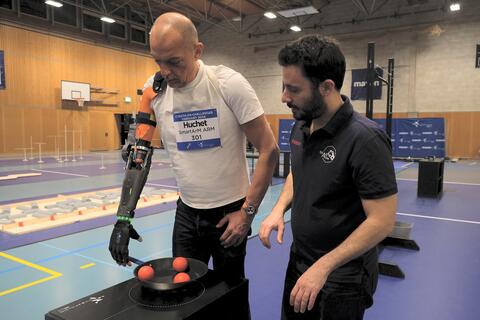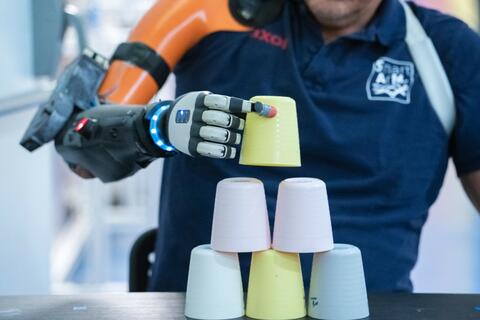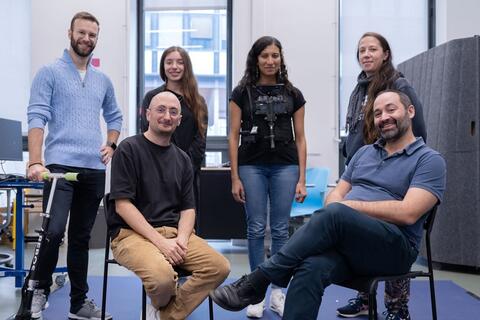
Cybathlon 2024: Advanced Prosthetics and Assistive Solutions
The 2024 Cybathlon is here! The international competition, blending technology with the challenges of daily life, offers a unique opportunity to test solutions that could revolutionize the field of prosthetics and assistive devices. The team led by Nathanaël Jarrassé, a researcher at ISIR, is ready to compete. With its Smart ArM and Smart Arm ROB projects, it positions itself at the cutting edge of robotic innovations for people with disabilities.
Smart ArM: Controlling prosthetics using body movements
The Smart Arm project, led by Nathanaël Jarrassé, was launched in 2019 after years of research on upper limb prosthetics. This research focused on how prosthetic users could control artificial limbs by harnessing residual body signals, such as muscle contractions and compensatory movements. “We have developed systems that allow a prosthesis to respond more precisely to muscle commands, notably by analyzing myoelectric signals more accurately and training users,” explains Nathanaël Jarrassé.
In 2019, the Smart Arm team met Christophe Huchet, a former para-athlete born without a right forearm, and began working with him. “Unlike a traumatic amputee, Christophe has never had a forearm, which changes everything in terms of body perception and relationship with the prosthesis,” notes the researcher. The team developed an exoskeletal elbow coupled with a socket equipped with multiple electrodes that capture residual muscle movements with far greater precision than a standard commercial prosthesis.
Since then, the team has continued to improve the technology. Collaborations with the New Zealand company Taska have enabled the integration of highly advanced digital prosthetic hands, along with even more precise motion control. Thanks to the eight electrodes in his prosthesis, the pilot, Christophe Huchet, can now adjust the speed of his movements, gently closing his hand on small objects, or more quickly on larger items. Using his body movements, measured by inertial sensors, he can simultaneously control the elbow and wrist of the prosthesis.
In pictures
Smart Arm ROB: A robotic arm for severe paralysis
Beyond material improvements, the team’s research on motion control algorithms has also made advances. These algorithms, which utilize residual body movements, have proven applicable to people with more severe disabilities, such as full or partial paralysis of the lower and upper limbs. “We found that our approaches could be adapted to offer control of an assistive robotic arm to individuals with a high level of paralysis,” adds Nathanaël Jarrassé.
This is the context in which the Smart Arm ROB project was born. “We have worked on control approaches based on movement for robotic arms mounted on wheelchairs,” explains Nathanaël Jarrassé. These devices, available for several years, are intended for people with significant disabilities like tetraplegia or locked-in syndrome. They allow users to perform everyday tasks like grabbing objects. However, controlling these arms remains challenging and restrictive.
“To overcome these limitations, we developed a robotic arm paired with an onboard computer and cameras that capture the person’s residual body movements, like those of the neck, shoulders, or torso, and then project them onto the robot. This offers a non-invasive solution suited to the users’ abilities,” explains the researcher. The team has also incorporated an augmented reality headset for head-based control. “The key to our innovations is to have different control components based on phantom movements, AI for decoding muscle contractions, body coordination, compensatory movements, etc., to provide a solution tailored to the individual, based on their abilities and preferences.”
To test their device, the team has been collaborating for several months with Étienne Moullet. This former ISIR doctoral student in neuroscience and robotics is tetraplegic and serves as the Smart Arm ROB team pilot for the Cybathlon 2024. “Étienne is an expert in robotic control issues,” highlights Nathanaël Jarrassé. Now a postdoctoral researcher at INRIA, he is working on using object recognition to optimize the control of functional electrical stimulation of hand muscles in tetraplegic individuals, helping them adopt the best grasp posture. “In the future, we hope to integrate a more sophisticated robotic hand that, thanks to Étienne’s research, could automatically select the best configuration for grabbing objects of different sizes and shapes,” says the researcher.
Until these latest developments are complete, pilots Étienne Moullet and Christophe Huchet train weekly with the ISIR scientific teams in preparation for the Cybathlon competition at the end of October. It is a true “real-world test” for these promising technologies.

Entraînement de l'équipe Smart Arm Rob ©Sorbonne Université
The Cybathlon: a unique platform to showcase innovation
More than just a competition, the Cybathlon is a technological showcase where devices developed for people with disabilities are tested in everyday tasks. Since the first edition in 2016, Nathanaël Jarrassé has been a strong advocate of the event. “Initially, we had doubts about the message conveyed by these competitions. But attending the event in Zurich, we realized how much it highlights the human aspect and stimulates research,” says the scientist.
The Cybathlon is unique in its focus on the daily challenges faced by people with disabilities, a crucial aspect according to Nathanaël Jarrassé: “The Cybathlon emphasizes that daily life, for people with disabilities, is a high-level sport.” This event pushes teams to adapt their technologies to users' needs and provides a unique environment to test devices in settings close to real life, far beyond laboratory conditions.
For Nathanaël Jarrassé and his team, the goal of the Cybathlon is not to win medals but to draw attention to research targeting often overlooked levels of disability. “We’re not here to win but to showcase our research, particularly on high-level upper limb amputations.” Unlike the focus on hand prosthetics, few studies focus on amputations at the elbow or shoulder, a crucial area. “These amputations often affect young, active individuals, workers, or farmers, for whom adapted solutions are essential,” explains the researcher.

Transferring innovation to industry
Nathanaël Jarrassé’s ambition does not stop at the Cybathlon. “There’s the lab, the Cybathlon, but also the outside world,” he notes. This approach anticipates the future of research aimed at making these technologies practical for everyday life. This summer, pilot Christophe Huchet used the arm prosthesis at home for the first time, performing household tasks like emptying the dishwasher or cooking, outside the competitive Cybathlon setting. “This shows we’ve reached a new level of maturity and realism in our innovations,” says the researcher, whose team won a Cybathlon challenge in 2022.
Ultimately, one of the team’s goals is to transfer its innovations to industry so they can benefit a larger audience. “Our aim is for manufacturers to implement our control algorithms on existing commercial equipment to expand user capabilities,” he says. The Extender project led by Guillaume Morel, a professor of robotics at Sorbonne University, developed in partnership with the French company Orthopus, shares this ambition. Supported by public funding, it aims to produce a six-degree-of-freedom robotic assistive arm similar to the one used in the Cybathlon.
The team’s research is also part of a larger project called Réinvent. Supported by the PEPR O2R, this project began a few months ago and will span eight years with a budget of over 3.5 million euros. “It brings together partners from social sciences, clinical labs, and leading robotics and neuroscience teams in France,” explains Nathanaël Jarrassé. The objective is ambitious: “to explore ways of reinventing prosthetics,” states the researcher. The project aims to reconcile the individual needs of users with a renewed perception of prosthetic devices, following a multidisciplinary approach combining anthropology, technical ethnology, and user feedback.
Far from the myth of augmented humans and cyborgs, Nathanaël Jarrassé and his team continue to work in a humanistic and ethical approach to facilitate the lives of people with prosthetics and to raise public awareness of the daily challenges they face.
All events will be broadcast live from October 25 to 27 on the Cybathlon website.
Learn more about the competition’s full program.
All events will be broadcast live from October 25 to 27 on the Cybathlon website.
Discover the competition's full program.






